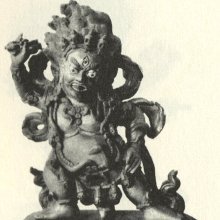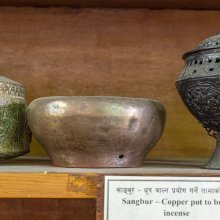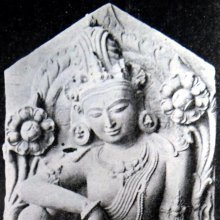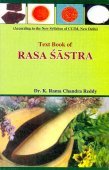Dhupa, Dhūpa: 30 definitions
Introduction:
Dhupa means something in Buddhism, Pali, Hinduism, Sanskrit, Marathi, Hindi, biology. If you want to know the exact meaning, history, etymology or English translation of this term then check out the descriptions on this page. Add your comment or reference to a book if you want to contribute to this summary article.
Images (photo gallery)
(+6 more images available)
In Hinduism
Shaktism (Shakta philosophy)
Source: Wisdom Library: ŚāktismDhūpa (धूप, “incense”):—One of the five preliminary oblations (upacāra) to be offered during the worship of Gaṇeśa, Durgā, Śiva and Viṣṇu, according to the Durgāpūjātattva.
Source: Google Books: ManthanabhairavatantramDhūpa (धूप) refers to the “incense”, according to the Kularatnoddyota verse 2.12-20.—Accordingly, “[...] (He worshipped thus) with (offerings) of the most excellent and divine Great Incense (mahā-dhūpa-vara) and many kinds of ornaments, established in supreme non-duality with (substances) born from (his) great bodily essence. Endowed with supreme bliss and holding the great argha vessel, the Lord of the gods, worshipped, O dear one, the great and excellent Wheel and he, the emperor and Lord of the Śrīkula, deftly put all the Śrīkramas, including the sequence of the Child and the rest, in place in accord with the sequence”.

Shakta (शाक्त, śākta) or Shaktism (śāktism) represents a tradition of Hinduism where the Goddess (Devi) is revered and worshipped. Shakta literature includes a range of scriptures, including various Agamas and Tantras, although its roots may be traced back to the Vedas.
Purana and Itihasa (epic history)
Source: Wisdom Library: Padma-puranaDhūpa (धूप) refers to “incense” and is used in the worship of Gaṇeśa, according to the Padmapurāṇa 1.65 (“The Slaying of Kālakeya”).—Accordingly, as Vyāsa said:—“[...] The king is not angry with him; plague does not occur in his house; he does not feel the dearth (of anything); he does not suffer from weakness after (i.e. due to his) having worshipped Gaṇeśa. ‘(My) salutation to the chief of the Gaṇas, who removes all difficulties, who was worshipped even by gods for accomplishing their desired objects’. The sacred formula is: ‘Om, salutation to Gaṇapati’. He, who would worship the protector of the Gaṇas, with flowers dear to Viṣṇu, and other fragrant flowers, with modakas, fruits, roots and other seasonal things, with curds and milk, pleasing musical instruments, and with incense and (other) fragrant (objects) [i.e., dhūpa—dhūpasugaṃdhibhiḥ] obtains success in all undertakings. [...]”.
Source: archive.org: Shiva Purana - English TranslationDhūpa (धूप, “incense”) refers to “offering of incense” and represents one of the sixteen upacāra, or “sixteen types of homage and services”, as described while explaining the mode of worshipping the phallic form (liṅga) of Śiva in the Śivapurāṇa 1.11. Accordingly, “[...] the devotee shall worship the mobile emblem with the sixteen types of homage and services (upacāra) as prescribed. It accords the region of Śiva gradually. The sixteen types of service are [for example, offering of incense (dhūpa)] [...] Or he shall perform all the sixteen rites in the phallic emblem of human, saintly or godly origin, or in one naturally risen up (svayambhū) or in one of very extraordinary nature installed duly”.
Dhūpa or Dhūpasamarpaṇa (offering of incense) is also mentioned in the Śivapurāṇa 1.20, while explaining the mode of worshipping an earthen phallic image (pārthiva-liṅga) according to the Vedic rites:—“[...] the incense (dhūpa) shall be offered with the mantra ‘Namaḥ Kapardine ca’ etc. in accordance with the rules. The lamp shall be offered in the prescribed manner with the mantra ‘Namaḥ Āśave’ etc.”.
Source: Cologne Digital Sanskrit Dictionaries: The Purana IndexDhūpa (धूप).—Burning of incense; guggula (bdellium) and Turuṣka (olibanum) best for honouring Pitṛs.*
- * Vāyu-purāṇa 75. 32; 109. 40.

The Purana (पुराण, purāṇas) refers to Sanskrit literature preserving ancient India’s vast cultural history, including historical legends, religious ceremonies, various arts and sciences. The eighteen mahapuranas total over 400,000 shlokas (metrical couplets) and date to at least several centuries BCE.
Shaivism (Shaiva philosophy)
Source: Shodhganga: Temple management in the ĀgamasDhūpa (धूप) refers to “fragrant incense” and represents one of the various upacāras (offerings), in pūjā (ritual worship), as defined in the Śaivāgamas.—Pūjā consists of offering hospitality, in the form of water to wash the feet, to drink, water for ablutions, offering a bath, new clothes, fragrant unguents, fragrant flowers and ornaments, food and so on. Each step in the pūjā process is called “saṃskāra” and each offering is called “upacāra” [viz., Dhūpa].
Source: SOAS University of London: Protective Rites in the Netra TantraDhūpa (धूप) refers to “perfume” (used in worship), according to the Netratantra of Kṣemarāja: a Śaiva text from the 9th century in which Śiva (Bhairava) teaches Pārvatī topics such as metaphysics, cosmology, and soteriology.—Accordingly, [verse 2.20-22ab]—“[The Mantrin] should worship the mother of mantras with the highest bhakti, by spreading flowers and perfume (dhūpa—puṣpadhūpādivistaraiḥ), O Devī. He should extract the deity invoked by the Mantra [with the mantra]. Beginning with the all-pervading and ending with manifold [oṃ], [he should] always [worship with] the nectar of the white flower. The bright sound is highest Śakti, [who] resembles one-in-the-same Śiva. By this [worship] the pearls [of the mantra] are all bound in a cord”.

Shaiva (शैव, śaiva) or Shaivism (śaivism) represents a tradition of Hinduism worshiping Shiva as the supreme being. Closely related to Shaktism, Shaiva literature includes a range of scriptures, including Tantras, while the root of this tradition may be traced back to the ancient Vedas.
Vaishnavism (Vaishava dharma)
Source: Pure Bhakti: Arcana-dipika - 3rd EditionDhūpa (धूप) refers to “incense” and represents one of the articles offered during Maṅgalārati, according to the Arcana-dīpikā (manual on deity worship).—Before each article is offered, purify the right hand [with a drop of water from the pañca-pātra], and then purify the article [viz., dhūpa]. Chant the mūla-mantra for the deity and then offer the article.

Vaishnava (वैष्णव, vaiṣṇava) or vaishnavism (vaiṣṇavism) represents a tradition of Hinduism worshipping Vishnu as the supreme Lord. Similar to the Shaktism and Shaivism traditions, Vaishnavism also developed as an individual movement, famous for its exposition of the dashavatara (‘ten avatars of Vishnu’).
Ayurveda (science of life)
Source: archive.org: Vagbhata’s Ashtanga Hridaya Samhita (first 5 chapters)Dhūpa (धूप) refers to “incense”, which is mentioned in verse 3.15 of the Aṣṭāṅgahṛdayasaṃhitā (Sūtrasthāna) by Vāgbhaṭa.—Accordingly, “[...] Passionate (and) lovely women with exuberant thighs, breasts, and buttocks take away the cold, their body being hot with incense [viz., dhūpa], saffron, and youth. [...]”.
Note: The instrumental dvandva “dhūpakuṅkumayauvanaiḥ”—“with incense, saffron, and youth” has been disconnected from its governing noun, separated into its three components, and converted by the requisite additions and alterations into a series of subject attributes: dhūpa (“incense”) becoming spos-kyis bdugs (“fumigated with incense”), kuṅkuma (“saffron”)—gur-gum-gyis byugs (“anointed with saffron”), and yauvana (“youth”)—gźon (“young”). At the same time, dhūpa and kuṅkuma have been interchanged, —sllos (for spos) in C and probably also bdug (for bdugs) in CD are xylographical errors.

Āyurveda (आयुर्वेद, ayurveda) is a branch of Indian science dealing with medicine, herbalism, taxology, anatomy, surgery, alchemy and related topics. Traditional practice of Āyurveda in ancient India dates back to at least the first millenium BC. Literature is commonly written in Sanskrit using various poetic metres.
Jyotisha (astronomy and astrology)
Source: Wisdom Library: Brihat Samhita by VarahamihiraDhūpa (धूप) refers to “(perfumed) smoke”, according to the Bṛhatsaṃhitā (chapter 12), an encyclopedic Sanskrit work written by Varāhamihira mainly focusing on the science of ancient Indian astronomy astronomy (Jyotiṣa).—Accordingly, “[...] I will now speak of the rules of the arghya (offering) to be presented to Agastya as stated by the Ṛṣis. [...] When the darkness of the night should just begin to be broken by streaks of red light from the eastern horizon, princes, previously prepared for the purpose, ought to offer their arghya to Agastya by pouring it on the Earth in the direction of the star Canopus rising in the south-east as will be pointed out by the astronomer. The offering to be made by princes in honor of Agastya shall consist of the fragrant flowers of the season, of fruits, of precious stones, of gold cloths, of cows, of bulls, of well-cooked rice, of sweet-meats, of curdled milk, of colored rice, of perfumed smoke [i.e., surabhi-dhūpa] and fragrant paste”.

Jyotisha (ज्योतिष, jyotiṣa or jyotish) refers to ‘astronomy’ or “Vedic astrology” and represents the fifth of the six Vedangas (additional sciences to be studied along with the Vedas). Jyotisha concerns itself with the study and prediction of the movements of celestial bodies, in order to calculate the auspicious time for rituals and ceremonies.
Ganapatya (worship of Ganesha)
Source: archive.org: Shiva Purana - (Ganesha)Dhūpa (धूप) refers to “incense” (used in the worship of Gaṇeśa), according to the Śivapurāṇa 2.4.18 (“Gaṇeśa crowned as the chief of Gaṇas”).—Accordingly, as Śiva said to Gaṇeśa: “[...] Gaṇeśa shall be adored with incense (dhūpa), lamps and different kinds of food-offerings. After worshipping you with various articles of worship like betel etc. and eulogising you with hymns, the devotee shall worship the crescent moon. Afterwards, he shall feed the brahmins joyously with sweets with due honour. He himself shall take sweets and avoid salt. [...]”.
Ganapatya (गाणपत्य, gāṇapatya) represents a tradition of Hinduism where Ganesha is revered and worshipped as the prime deity (ishta-devata). Being a minor though influential movement, Ganapatya evovled, llike Shaktism and Shaivism, as a separate movement leaving behind a large body of literature.
General definition (in Hinduism)
Source: ACHC: Smarta PujaDhūpa (धूप) refers to “offering incense”, representing one of the various services (upacāra) of a pūjā (ritualistic worship of a deity) which aim at the purification of the devotee.—The devotee waves incense sticks (dhūpa) in front of the icon. If pieces of incense are used, these are burnt in a special vessel with a handle (dhūpa-pātra). Simultaneously the worshipper rings the bell which—he holds in his left hand. The ringing of the bell is prescribed at several stages of the pūjā, e.g. when offering food or waving the ārati.498 Incense is believed to purify the air and drive away evil spirits.
In Buddhism
Tibetan Buddhism (Vajrayana or tantric Buddhism)
Source: OSU Press: Cakrasamvara SamadhiDhūpa (धूप) refers to “incense”, according to the Guru Mandala Worship (maṇḍalārcana) ritual often performed in combination with the Cakrasaṃvara Samādhi, which refers to the primary pūjā and sādhanā practice of Newah Mahāyāna-Vajrayāna Buddhists in Nepal.—Accordingly, “Incense and light (dhūpa-dīpa), the end of all consecrations, is equally splendid, I invite calmness and tranquility, rendering all knowledge clear”.

Tibetan Buddhism includes schools such as Nyingma, Kadampa, Kagyu and Gelug. Their primary canon of literature is divided in two broad categories: The Kangyur, which consists of Buddha’s words, and the Tengyur, which includes commentaries from various sources. Esotericism and tantra techniques (vajrayāna) are collected indepently.
Biology (plants and animals)
Source: Google Books: CRC World Dictionary (Regional names)1) Dhupa in India is the name of a plant defined with Ailanthus triphysa in various botanical sources. This page contains potential references in Ayurveda, modern medicine, and other folk traditions or local practices It has the synonym Adenanthera triphysa Dennst., Fabaceae (among others).
2) Dhupa is also identified with Boswellia serrata It has the synonym Boswellia glabra Roxb. ex Colebr. (etc.).
3) Dhupa is also identified with Jurinea dolomiaea.
4) Dhupa is also identified with Jurinea macrocephala It has the synonym Jurinea macrocephala Benth. (etc.).
5) Dhupa is also identified with Vateria indica It has the synonym Vateria malabarica Blume (etc.).
Example references for further research on medicinal uses or toxicity (see latin names for full list):
· Journal of Physics D: Applied Physics
· Agents Actions (1986)
· Nouveau Bulletin des Sciences, Publie par la Société Philomatique de Paris (1821)
· Tetrahedron Letters (5909)
· Suppl. Carp. (1805)
· Phytochem. Anal. (2001)
If you are looking for specific details regarding Dhupa, for example diet and recipes, health benefits, side effects, pregnancy safety, extract dosage, chemical composition, have a look at these references.

This sections includes definitions from the five kingdoms of living things: Animals, Plants, Fungi, Protists and Monera. It will include both the official binomial nomenclature (scientific names usually in Latin) as well as regional spellings and variants.
Languages of India and abroad
Pali-English dictionary
Source: BuddhaSasana: Concise Pali-English Dictionarydhūpa : (m.) incense.
Source: Sutta: The Pali Text Society's Pali-English DictionaryDhūpa, (Sk. dhūpa of Idg. *dhūp, enlarged fr. *dhū in dhunāti (q. v.)) incense J.I, 51, 64, 290 (gandha°, dvandva, cpd.); III, 144; VI, 42; PvA.141 (gandhap̄uppha°). dh°ṃ dadāti to incense (a room) J.I, 399. Sometimes misspelt dhūma, e.g. VvA.173 (gandhapuppha°). (Page 343)

Pali is the language of the Tipiṭaka, which is the sacred canon of Theravāda Buddhism and contains much of the Buddha’s speech. Closeley related to Sanskrit, both languages are used interchangeably between religions.
Marathi-English dictionary
Source: DDSA: The Molesworth Marathi and English Dictionarydhupā (धुपा).—m A kind of grass. 2 A kind of reed.
--- OR ---
dhūpa (धूप).—m (S) Common frankincense. 2 Any fragrant gum or resin burned before idols &c: also the fragrant vapor exhaled on combustion. 3 f ( H) Sunshine. dhūpa ghālaṇēṃ To burn incense before a person possessed; that the demon may speak. Hence to court solicitously, sue, woo (a person to speak). dhūpa dākhaviṇēṃ (To show or offer incense.) To tantalize or mock (and give nothing).
Source: DDSA: The Aryabhusan school dictionary, Marathi-Englishdhūpa (धूप).—m Common frankincense. Sunshine. dhūpa ghālaṇēṃ To burn incense before a person possessed. To court solicitous- ly, sue, woo (a person to speak). dhūpa dākhaviṇēṃ To show or offer incense.
Marathi is an Indo-European language having over 70 million native speakers people in (predominantly) Maharashtra India. Marathi, like many other Indo-Aryan languages, evolved from early forms of Prakrit, which itself is a subset of Sanskrit, one of the most ancient languages of the world.
Sanskrit dictionary
Source: DDSA: The practical Sanskrit-English dictionaryDhūpa (धूप).—[dhūp-ac]
1) Incense, frankincense, perfume, any fragrant substance.
2) The vapour issuing from any fragrant substance (like gum, resin &c.), aromatic vapour or smoke; धूपोष्मणा त्याजितमार्द्रभावम् (dhūpoṣmaṇā tyājitamārdrabhāvam) Kumārasambhava 7.14; Meghadūta 34; V.3.2; R.16.5.
3) A fragrant powder.
Derivable forms: dhūpaḥ (धूपः).
Source: Cologne Digital Sanskrit Dictionaries: Edgerton Buddhist Hybrid Sanskrit DictionaryDhūpā (धूपा).—‘Incense’, name of a goddess or yoginī: Sādhanamālā 50.3 etc.; 324.6.
Source: Cologne Digital Sanskrit Dictionaries: Shabda-Sagara Sanskrit-English DictionaryDhūpa (धूप).—m.
(-paḥ) Incense, the aromatic vapour that proceeds from the combustion of any fragrant gum or resin, the use of which is authorized by scripture. E. dhūp to heat, affix ac. dhapayati rogān doṣān vā .
Source: Cologne Digital Sanskrit Dictionaries: Benfey Sanskrit-English DictionaryDhūpa (धूप).—[dhūp + a], m. 1. Incense, [Rāmāyaṇa] 1, 5, 15. 2. The aromatic vapour that proceeds from the burning of incense, [Vikramorvaśī, (ed. Bollensen.)] [distich] 43.
Source: Cologne Digital Sanskrit Dictionaries: Cappeller Sanskrit-English DictionaryDhūpa (धूप).—([masculine] sgl. & [plural]) incense, perfume; smoke, vapour.
Source: Cologne Digital Sanskrit Dictionaries: Monier-Williams Sanskrit-English Dictionary1) Dhūpa (धूप):—[from dhū] m. ig. [plural] ([from] dhū as puṣpa [from] √puṣ, stūpa [from] √stu) incense, perfume, aromatic vapour or smoke proceeding from gum or resin, the g° and r° themselves, [Kāṭhaka; Gṛhya-sūtra; Yājñavalkya; Mahābhārata; Kāvya literature] etc.
2) [v.s. ...] one of the 16 acts of homage or offerings in the Pañcāyatara ceremony, [Religious Thought and Life in India 415.]
Source: Cologne Digital Sanskrit Dictionaries: Yates Sanskrit-English DictionaryDhūpa (धूप):—(paḥ) 1. m. Incense.
Source: DDSA: Paia-sadda-mahannavo; a comprehensive Prakrit Hindi dictionary (S)Dhūpa (धूप) in the Sanskrit language is related to the Prakrit word: Dhūva.
[Sanskrit to German]
Sanskrit, also spelled संस्कृतम् (saṃskṛtam), is an ancient language of India commonly seen as the grandmother of the Indo-European language family (even English!). Closely allied with Prakrit and Pali, Sanskrit is more exhaustive in both grammar and terms and has the most extensive collection of literature in the world, greatly surpassing its sister-languages Greek and Latin.
Hindi dictionary
Source: DDSA: A practical Hindi-English dictionaryDhūpa (धूप) [Also spelled dhup]:—(nf) the sun; sunshine; incense, gum benzoin; ~[ghaḍī] a sundial; —[caḍhanā] the sun to rise high in the sky, to be nearing midday; -[chāṃha] sun and shade; a kind of cloth with a sun and shade touch; (fig.) happiness and sorrow; ~[dāna] an incensory; a thurible; thurification, incensing; ~[dānī/pātra] an incensory, a thurible; ~[dāra] sunny; -[dīpa] accessories for worship—incense (—stick) and lamp; ~[battī] an incense-stick; ~[snāna] basking; —[khānā] to bask in the sun; to be heat-struck; to be sun-treated; —[dikhānā] to put or spread in the sun; —[denā] to burn incense (for religious performance); to spread out in the sun (as clothes etc.); —[meṃ bāla sapheda honā] to age without experience; to be old and yet devoid of wisdom; —[lenā/-sekanā] to bask in the sun.
...
Kannada-English dictionary
Source: Alar: Kannada-English corpusDhūpa (ಧೂಪ):—
1) [noun] several kinds of myrrh-like resins exuded from certain trees, that give fragrant smoke.
2) [noun] fragrant smoke emitted by such a resin.
3) [noun] smoke, in gen. 4. the tree Ailanthus malabarica of Simaroubaceae family.
4) [noun] the large, evergreen tree Vateria indica.
5) [noun] ಧೂಪದ ಕಡ್ಡಿ [dhupada kaddi] dhūpada kaḍḍi a thin stick burned to get fragrant fumes, esp. in religious rites; an incense stick; ಧೂಪದ ಕೊಡ [dhupada koda] dhūpada koḍa a container for burning fragrant resins to get incense; ಧೂಪದ ಬತ್ತಿ [dhupada batti] dhūpada batti = ಧೂಪದ ಕಡ್ಡಿ [dhupada kaddi]; ಧೂಪದ ಮರ [dhupada mara] dhūpada mara = ಧೂಪ - [dhupa -] 4, 5 & 6; ಧೂಪಮಂ ತೋರು [dhupamam toru] dhūpamam tōru to wave the container having burning fragrant resins, before an idol; 2. (fig.) to urge to action; to stir up (another’s mind); to rouse emotions; to incite; to instigate.
Kannada is a Dravidian language (as opposed to the Indo-European language family) mainly spoken in the southwestern region of India.
See also (Relevant definitions)
Starts with (+95): Dhupa fat, Dhupa mara, Dhupa maram, Dhupa-halnu, Dhupaarati, Dhupabali, Dhupabati, Dhupabatti, Dhupabhajana, Dhupacem Jhada, Dhupachayam, Dhupada, Dhupada-mara, Dhupadamar, Dhupadamara, Dhupadammar, Dhupadammara, Dhupadana, Dhupadani, Dhupadayaka.
Ends with (+46): Adhupa, Agarudhupa, Agurudhupa, Amtardhupa, Bagadhupa, Baggada-dhupa, Baggadadhupa, Bakadhupa, Bili-dhupa, Bilidhupa, Chilakadhupa, Cilakadhupa, Daudadhupa, Devadhupa, Dhavadhupa, Dohadadhupa, Goguladhupa, Gugguladhupa, Gugguldhupa, Gugguludhupa.
Full-text (+113): Dhupanga, Vrikshadhupa, Khadhupa, Kritrimadhupa, Kliptadhupa, Dhupavriksha, Devadhupa, Vrikadhupa, Dhupapatra, Suradhupa, Dhupika, Dhupaka, Dhupaguru, Dhupanetra, Vidhupa, Kopacchada, Dhuparha, Dhupayati, Bakadhupa, Meddi dhupa.
Relevant text
Search found 38 books and stories containing Dhupa, Dhūpa, Dhupā, Dhūpā; (plurals include: Dhupas, Dhūpas, Dhupās, Dhūpās). You can also click to the full overview containing English textual excerpts. Below are direct links for the most relevant articles:
Vedic influence on the Sun-worship in the Puranas (by Goswami Mitali)
Sun-worship Vratas (47) Śāka-saptamī < [Chapter 5 - Rituals Related to the Sun-Worship in the Purāṇas]
Sun-worship Vratas (34) Mahā-saptamī < [Chapter 5 - Rituals Related to the Sun-Worship in the Purāṇas]
Sun-worship Vratas (23) Nandā-saptamī < [Chapter 5 - Rituals Related to the Sun-Worship in the Purāṇas]
Mahabharata (English) (by Kisari Mohan Ganguli)
Section XCVIII < [Anusasanika Parva]
Section LXV < [Anugita Parva]
Section CLXXXIV < [Mokshadharma Parva]
Later Chola Temples (by S. R. Balasubrahmanyam)
Temples in Neyyadippakkam < [Chapter XIV - Temples of Rajaraja III’s Time]
Chaitanya Bhagavata (by Bhumipati Dāsa)
Verse 2.6.110 < [Chapter 6 - The Lord’s Meeting with Advaita Ācārya]
Verse 2.9.125 < [Chapter 9 - The Lord’s Twenty-One Hour Ecstasy and Descriptions of Śrīdhara and Other Devotees’ Characteristics]
Verse 3.6.70 < [Chapter 6 - The Glories of Śrī Nityānanda Prabhu]
The Indian Buddhist Iconography (by Benoytosh Bhattachacharyya)
Figure 105-108 - (Avalokiteśvara): Lokanātha
Figure 180-183 - Emanations of Ratnasambhava: Vajratārā and Puṣpatārā
Garga Samhita (English) (by Danavir Goswami)
Verses 6.5.23-24 < [Chapter 5 - The Kidnapping of Śrī Rukmiṇī]
Related products







